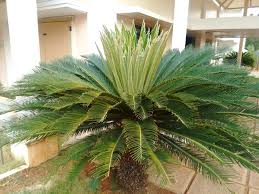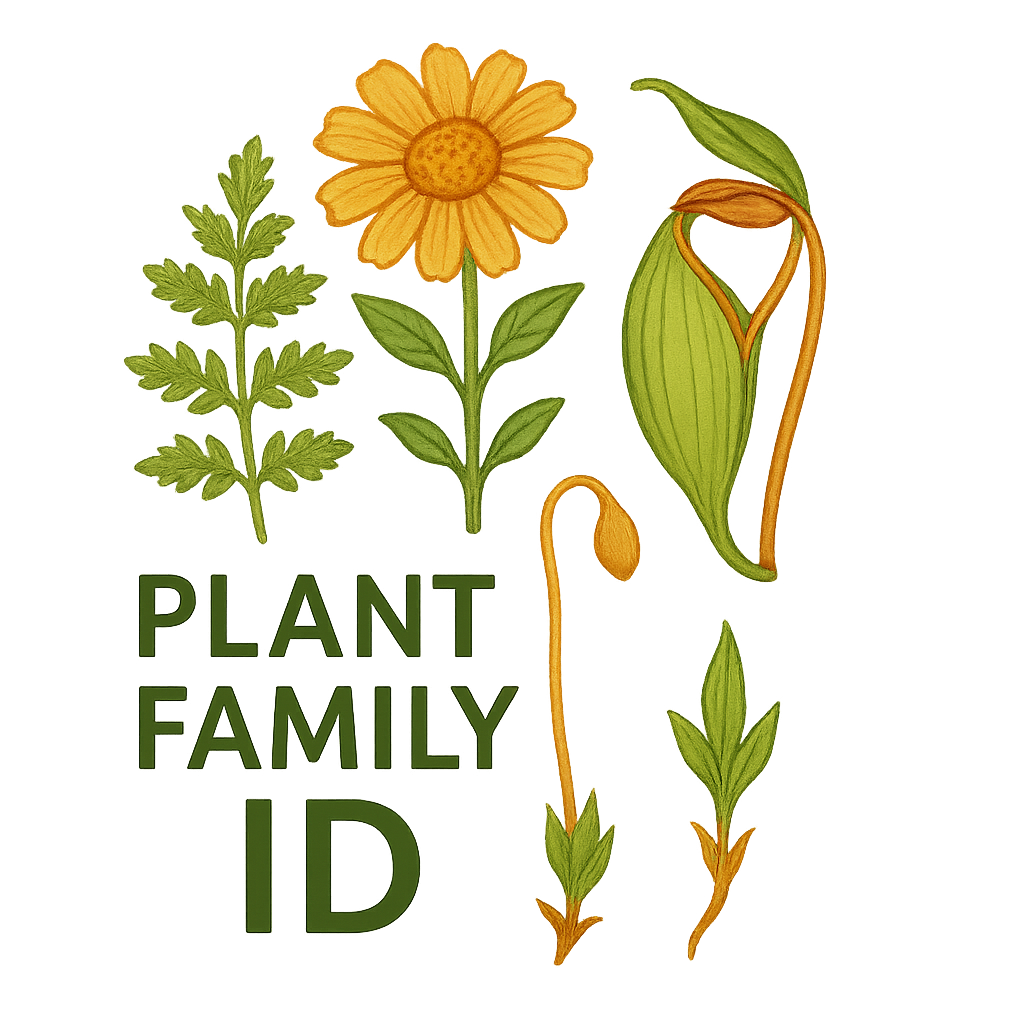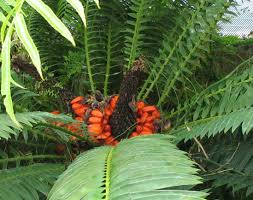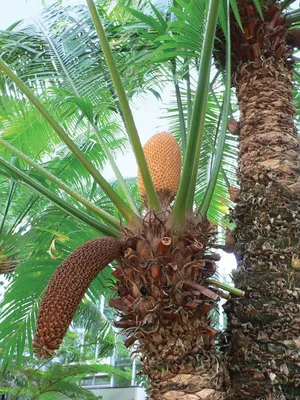Cycadaceae
Cycad Family
Cycadaceae is a family of gymnosperms containing the single living genus Cycas. These ancient, palm-like plants are characterized by stout trunks, a crown of large, pinnately compound leaves, and reproduction via cones (male) or specialized seed-bearing leaves (female megasporophylls), not flowers or fruits. They represent a lineage dating back hundreds of millions of years.

Overview
The Cycadaceae family, now restricted to the genus Cycas, includes about 110-120 species distributed across tropical and subtropical regions of the Old World and Pacific islands. They inhabit diverse environments, from rainforests to seasonally dry woodlands. As gymnosperms, they bear "naked" seeds not enclosed within an ovary/fruit.
Key features include their distinctive palm-like appearance, pinnately compound leaves with leaflets possessing a single, prominent midrib (unique to Cycas among cycads), and their dioecious nature (separate male and female plants). Male plants produce large pollen cones, while female plants produce specialized leaf-like structures (megasporophylls) bearing large ovules. They also possess specialized coralloid roots housing nitrogen-fixing cyanobacteria.
Cycads are often called "living fossils" due to their ancient lineage and relatively unchanged morphology over millions of years. Many species are slow-growing, long-lived, and face conservation threats due to habitat loss and collection.
Quick Facts
- Scientific Name: Cycadaceae Pers.
- Common Name: Cycad Family
- Number of Genera: 1 (Cycas)
- Number of Species: Approximately 110-120
- Distribution: Pantropical/subtropical Old World & Pacific (E. Africa, Madagascar, India, SE Asia, China, Japan, Australia, Pacific Islands)
- Evolutionary Group: Gymnosperms - Cycadophyta - Cycadales
Key Characteristics
Growth Form and Habit
Members are typically palm-like evergreen shrubs or small trees with stout, woody, often unbranched trunks (pachycaul). Trunks can be subterranean or aerial and are usually covered in persistent leaf bases. Growth is generally very slow.
Leaves
Leaves are large, pinnately compound, resembling fern fronds or palm leaves, arranged spirally in a dense terminal crown. The leaflets (pinnae) are typically numerous, leathery, linear or lance-shaped, and possess a characteristic single, prominent midrib with no other visible parallel veins (a key feature distinguishing Cycas from Zamiaceae). Young leaves often exhibit circinate vernation (coiling like a fern fiddlehead). Leaves lack stipules.
Reproductive Structures (No Flowers)
Cycadaceae plants are dioecious (separate male and female individuals). They reproduce via specialized structures, not flowers.
- Male Cones (Microstrobili): Male plants produce large, erect, cone-like structures in the center of the leaf crown. These consist of tightly packed, modified leaves (microsporophylls), each bearing numerous pollen sacs (microsporangia) on its lower surface, which release pollen when mature.
- Female Structures (Megasporophylls): Female Cycas plants do not form a true compact cone like other cycads (Zamiaceae). Instead, they produce successive whorls of individual megasporophylls in the apical crown, typically appearing after a flush of vegetative leaves. Each megasporophyll is a somewhat leaf-like, often hairy structure, bearing several large, exposed ovules along its margins.
Pollination is typically by wind or insects (often specific beetles). Fertilization involves motile sperm cells, an ancient trait shared with Ginkgo and some lower plants.
Seeds (No Fruits)
Following fertilization, the ovules develop into large naked seeds (not enclosed in a fruit). The seeds often have a brightly colored (red, orange, yellow), fleshy outer layer (sarcotesta) surrounding a hard inner stony layer (sclerotesta), making them resemble drupes superficially. Seeds contain toxic compounds like cycasin.
Roots
In addition to a primary taproot system, Cycadaceae possess specialized coralloid roots. These grow near the soil surface, are branched and nodular (resembling coral), and host symbiotic nitrogen-fixing cyanobacteria (blue-green algae, e.g., Nostoc), providing nutrients to the plant.
Chemical Characteristics
All parts of the plant, especially seeds, contain potent neurotoxins, primarily cycasin and related compounds, as well as BMAA (β-Methylamino-L-alanine). These serve as defenses against herbivores but make the plants dangerous if ingested without proper processing.
Field Identification
Identifying members of the Cycadaceae family (genus Cycas) involves recognizing their unique gymnosperm features and distinguishing them from superficially similar plants like palms or ferns:
Primary Identification Features
- Palm-like habit with stout trunk: Look for a thick, woody stem (aerial or subterranean) crowned with large leaves.
- Pinnately compound leaves: Leaves are divided into leaflets along a central rachis.
- Single midrib in leaflets: Examine individual leaflets (pinnae); they should have one prominent central vein and lack other parallel veins (unlike Zamiaceae).
- Reproductive structures: Look for large, central male cones OR loose whorls of large, seed-bearing megasporophylls in the crown (female plants). Remember: no flowers or fruits.
Secondary Identification Features
- Persistent leaf bases on trunk: The trunk surface is often rough with the bases of shed leaves.
- Coralloid roots: May be visible at the soil surface near the base of the plant as branched, nodular structures.
- Dioecious nature: A population will consist of separate male (cone-bearing) and female (megasporophyll-bearing) plants.
- Circinate vernation: Newly emerging leaves are coiled.
Seasonal Identification Tips
As evergreens, vegetative features are useful year-round:
- Year-round: Habit, trunk, leaf structure (pinnate, single midrib) are constant. Coralloid roots are persistent.
- Reproductive Season (Varies, often spring/summer): Appearance of male cones or female megasporophylls provides definitive identification and sex determination. Seeds may persist on female plants for extended periods.
Common Confusion Points
Distinguishing Cycadaceae (Cycas) requires careful observation:
- Palms (Arecaceae): Palms are Angiosperms with true flowers (usually small, in large inflorescences) and fruits (drupes, berries). Palm leaves (pinnate or palmate) have different venation (usually parallel veins along the leaflet/segment). They lack cones/megasporophylls.
- Ferns (Polypodiopsida): Share pinnate leaves and circinate vernation, but reproduce via spores (usually in sori on leaf undersides), lack woody trunks (except tree ferns, which have different stem structure), and lack cones/seeds.
- Zamiaceae (Other cycads): Superficially similar habit, but leaflets lack a single prominent midrib (they have multiple parallel veins or no distinct veins). Importantly, female Zamiaceae plants produce true, compact seed cones, unlike the loose megasporophylls of Cycas.
Field Guide Quick Reference
Look For:
- Palm-like gymnosperm
- Stout trunk (often with leaf bases)
- Large, pinnate leaves in crown
- Leaflets with single midrib
- Male cones OR Female megasporophylls (not true cones)
- Large, fleshy-coated seeds (not fruits)
- Coralloid roots at base
Key Variations:
- Trunk aerial or subterranean
- Leaflet shape and size varies by species
- Megasporophyll shape varies
- Seed color varies (orange, red)
- Found in Old World tropics/subtropics
Notable Examples
All examples belong to the single genus Cycas:

Cycas revoluta
Sago Palm / King Sago
Native to southern Japan, this is the most widely cultivated cycad globally, popular as an ornamental landscape and house plant. Known for its relatively short trunk and stiff, dark green leaves with slightly recurved leaflets. (Note: True sago starch comes from palms, not this cycad).

Cycas circinalis
Queen Sago
Native to Southern India, Sri Lanka, and parts of Southeast Asia. Generally larger than C. revoluta, with longer, broader, flatter leaflets that are often lighter green. Historically used as a source of starch (after careful processing to remove toxins).
Phylogeny and Classification
Cycadaceae belongs to the division Cycadophyta, order Cycadales – one of the major lineages of living Gymnosperms. This group represents an ancient lineage of seed plants that predates the evolution of flowering plants (Angiosperms) by hundreds of millions of years, with fossils resembling modern cycads found from the Permian period.
Within the Cycadales, molecular and morphological data strongly support Cycadaceae (containing only Cycas) as the sister group to the remaining families, Zamiaceae and Stangeriaceae. Key distinguishing features like the single leaflet midrib and the lack of true female cones in Cycas support this basal position. The relationship of Cycadales to other gymnosperm groups (Conifers, Ginkgo, Gnetales) is still an area of active research.
Position in Plant Phylogeny
- Kingdom: Plantae
- Clade: Tracheophytes (Vascular plants)
- Clade: Spermatophytes (Seed plants)
- Clade: Gymnosperms
- Division: Cycadophyta
- Order: Cycadales
- Family: Cycadaceae
Evolutionary Significance
Cycadaceae (and cycads in general) are immensely significant for understanding plant evolution:
- "Living Fossils": They retain many ancestral traits of early seed plants, providing insights into plant life before the dominance of angiosperms.
- Ancient Lineage: Represent one of the oldest living lineages of seed plants.
- Unique Reproduction: Features like motile sperm (rare in seed plants), specialized pollination mechanisms (often involving insects despite being gymnosperms), and the unique megasporophyll structure of Cycas are of great evolutionary interest.
- Symbiosis: The nitrogen-fixing symbiosis with cyanobacteria in coralloid roots is an important ecological adaptation.
- Conservation Biology: Many cycad species are endangered, making them a focus for conservation efforts and studies on extinction risk in ancient lineages.



